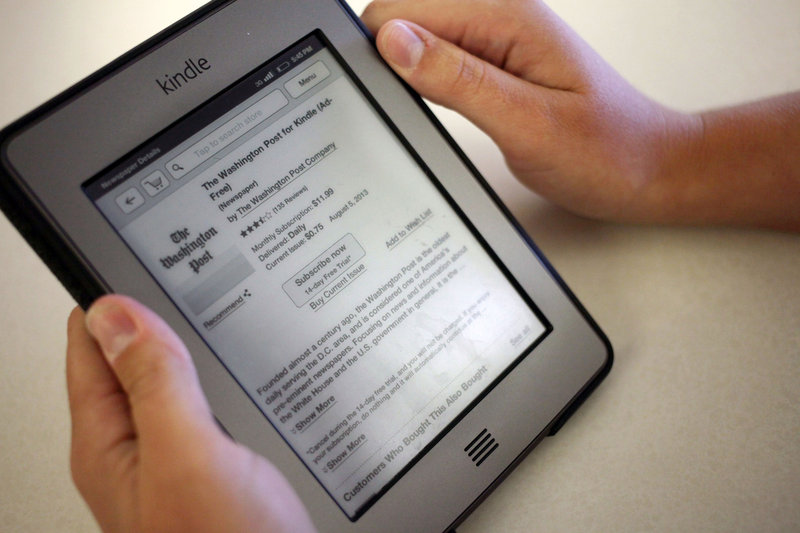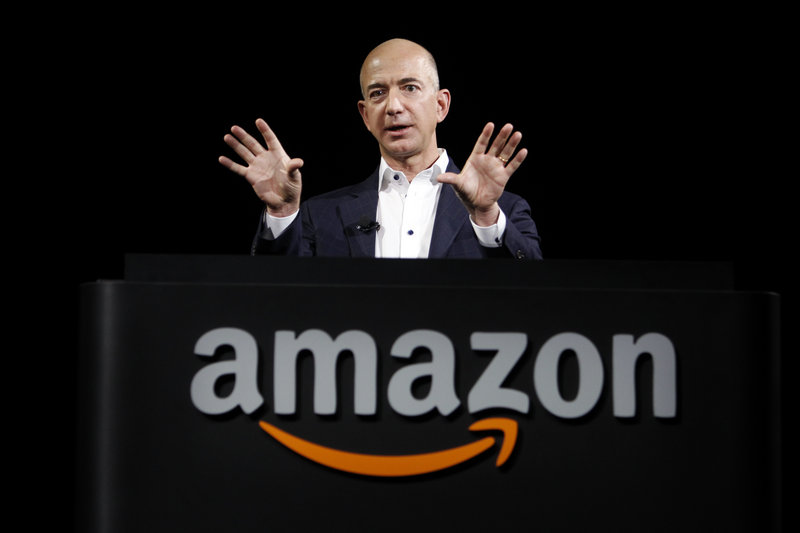SAN FRANCISCO — Amazon.com CEO Jeff Bezos is revered as one of the brightest minds in corporate America, but even he is still puzzling over how to reverse the financial slide threatening The Washington Post and other major U.S. newspapers.
Nevertheless, Bezos is determined to face the challenge, raising hope that his $250 million purchase of The Washington Post announced Monday will provide the newspaper industry with a template for making the leap from the printed page to digital devices.
“The marriage between the newspaper industry and technology has never been consummated, but it could happen at The Washington Post now,” said media analyst Ken Doctor of Outsell Inc.
Although Bezos bought The Post with his own money, most experts believe he is likely to tether the newspaper to Amazon.com Inc.’s products. He might also infuse the newspaper with some of the concepts that helped turn the Seattle company from an online book store into a multi-dimensional business that sells a multitude of merchandise and runs data centers that power other websites around the world.
“Just having his brain in the room (at The Washington Post) will force people to confront digital in a way they haven’t before,” predicted Jerry Ceppos, a former newspaper editor who is now dean of mass communications at Louisiana State University.
Bezos, 49, made it clear that he has no magic formula for turning the Post around. The broadsheet is the anchor of a newspaper division that lost $54 million at The Washington Post Co. last year while generating annual revenue of $582 million — 39 percent less than it did in 2005.
“There is no map, and charting a path ahead will not be easy,” Bezos wrote in a Monday letter sent to Post employees after his surprise acquisition was announced. “We will need to invent, which means we will need to experiment.”
According to an Amazon spokesman, Bezos wasn’t available to be interviewed Tuesday about his plans for the Post.
Amazon’s nearly two-decade history under Bezos’ leadership suggests the Post is likely to try things that other newspapers steeped in tradition have never dared to attempt.
“Ever since he was a little kid, it got deeply ingrained into Jeff that experimentation is the answer to everything,” said Hal Gregerson, who interviewed Bezos for his 2011 book, “The Innovator’s DNA.” “Exploring the edges is one of Jeff’s counter-intuitive skills. If you go back to when he started Amazon, he was paying attention to something out of the corner of his eye and turned it into something that others didn’t see.”
It’s impossible to predict the bright ideas Bezos might explore, partly because reviving the Post will probably take years to pull off. Experts are floating a host of ideas. Bezos could, for instance, deploy the technology that Amazon uses to recommend books, movies and music to consumers to enable the Post to automatically tailor digital news packages to each reader’s interests. He might impose more fees to read the Post’s content online while bundling free subscriptions as part of Amazon’s Kindle Fire tablet or consumers who buy Amazon’s “Prime” service for free shipping. He could even include special offers in the printed edition to deliver merchandise ordered through Amazon.com.
The Post and other newspapers might not be around that much longer, unless radical changes are made. Some of the biggest newspapers already have had to seek refuge in bankruptcy court to reshuffle their finances during the past five years and the outlook still looks grim. Analyst Doctor believes revenue is likely to continue to slip for the next five years, too.
Newspapers have been suffering because their main source of revenue — advertising sold in their print editions — has been drying up during the past eight years as their readers have discovered that they can keep up on the latest events for free or lower subscription rates through Facebook, Twitter, Yahoo, Google, specialty blogs and a variety of other digital outlets.
Most newspapers have intensified their focus on their own digital editions during the past few years, but still haven’t been able to overcome this fundamental problem: Digital ads typically sell for 10 percent to 50 percent less than print ads.
That gap is the chief reason that the annual print ad revenue at U.S. newspapers has plummeted 60 percent in just seven years, dropping from $47.4 billion in 2005 to $18.9 billion last year, according to the Newspaper Association of America. Over the same stretch, the industry’s digital ad revenue has climbed from $2 billion in 2005 to $3.4 billion last year.
The financial hole is so deep that it will be difficult for even a savvy Internet executive like Bezos to find a workable solution at The Post, said Christopher Harper, a journalism professor at Temple University.
“It’s not really a business deal, it’s almost an investment in a nonprofit,” Harper said.
It’s one Bezos can easily afford to make. The purchase price works out to just 1 percent of Bezos’ estimated $25 billion fortune. The mid-range of U.S. charitable contributions annually works out to nearly 5 percent of discretionary income, according to the Chronicle of Philanthropy.
Bezos is also in a better position to absorb ongoing losses at The Washington Post than the newspaper would have been had it remained part of a publicly held company under pressure to deliver better returns for a larger pool of shareholders.
“One of the smartest things is moving toward private ownership,” said Ellen Shearer, a journalism professor at Northwestern University. “I think that’s what a lot of papers need right now, particularly the Post.”
It’s likely that some of his ideas will fail, but that probably won’t bother Bezos. It took Amazon nearly a decade before it turned its first annual profit.
Send questions/comments to the editors.




Success. Please wait for the page to reload. If the page does not reload within 5 seconds, please refresh the page.
Enter your email and password to access comments.
Hi, to comment on stories you must . This profile is in addition to your subscription and website login.
Already have a commenting profile? .
Invalid username/password.
Please check your email to confirm and complete your registration.
Only subscribers are eligible to post comments. Please subscribe or login first for digital access. Here’s why.
Use the form below to reset your password. When you've submitted your account email, we will send an email with a reset code.